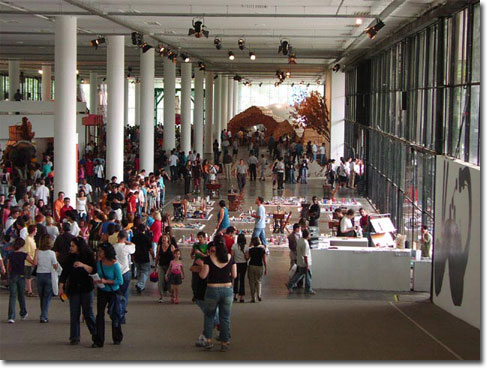Bienal de Sí¢o Paulo ,
Sep 01, 2004 - Dec 01, 2004
SÃ o Paulo, Brazil
Scenes from the Sço Paulo International Biennial
by Viviana Usubiaga
The curatorial script of the last São Paulo International Biennial, (from September to December, 2004) treated the event as an area without restrictions, almost a sanctuary, in which artists were free to erect their own Utopian structures. This area was thought of as an experimental ecological reserve, a place for the creation of transformative formulas that could encourage new relationships amongst viewers. The implementation of early twentieth century Modernist concepts gave rise to a somewhat faded proposal bearing little resemblance to the original idea. On the one hand we find an installation without surprises, divided into classic disciplines (notwithstanding photography which acted as a link throughout the entire space). And, on the other hand were textual statements related to social commitments and their topical projects resulting in discourses that were generally artificial and somewhat forced. Nonetheless, if we disregard the specific problems afflicting this Biennial, such as the incongruence between the aesthetic statements prepared by the curator, Alfons Hug, and the curatorial and spatial design, it is possible to give an overview of the works exhibited, and reflect upon other matters affecting contemporary art within this setting. I will attempt to draw a line of analysis concentrating specifically on the circumstances surrounding the work, allowing the spectator to experience this both physically and intellectually. The idea is to establish a purely intellectual reading based on an effective interpretation of the environment, insofar as this plays an important role when speculating as to its significance. This necessarily involves asking questions on matters such as how the work is presented or how it appears to the public. To ask oneself how this occurs or under what conditions and circumstances it materializes would imply defining the substratum or scene within which a specific interpretive repertory is executed and summarize how this staging occurs. This word is understood as an expanded category which underlines the essentially fictional nature of a work’s interpretation, criticizing the visual area and focusing on a viewpoint that emphasizes the question: what makes a work of art successful in a specific environment? Here, staging redefines the idea of environment or context by specific categories, showing the possible operation of art within our environment. Since Duchamp, art has displaced the object to the stage/scenario as a means of capturing different artistic practices forming narratives or visions of the world around us. Different strategies and historical movements which bring these reenactments forward: the geometric or architectural space of minimalism, the natural environment and the site-specificity of land art, the continual space-time handling of conceptualism, or the informational net-art space. From this vantage point, that defines a field of variable forces, one can make a specific analysis of the works of a group of artists that took part in this Biennial that represented relevant cases in relation to this staging concept. There are, on the one hand, works that play with architectural space itself and act as extensions or fictitious alterations of Oscar Niemeyer’s pavilion. Such is the case of Mike Nelson, Paulo Climachauska, Paulo Bruscky and Thiago Bortolozzo. The second nucleus consists of works which construct or call to crisis a staging in themselves and proposing alternative realities: Thomas Demand and Miguel Calderón. And, thirdly, a series of works one can experience only partially, since they are adaptations of other projects or are presented as stages where the performance, for example, has already taken place: Yin Xiuzhen and Song Dong, among others. The work of Mike Nelson (representing Great Britain) acts as an architectural appendix to the Biennial pavilion. It is in fact a room reached by the public through
|













